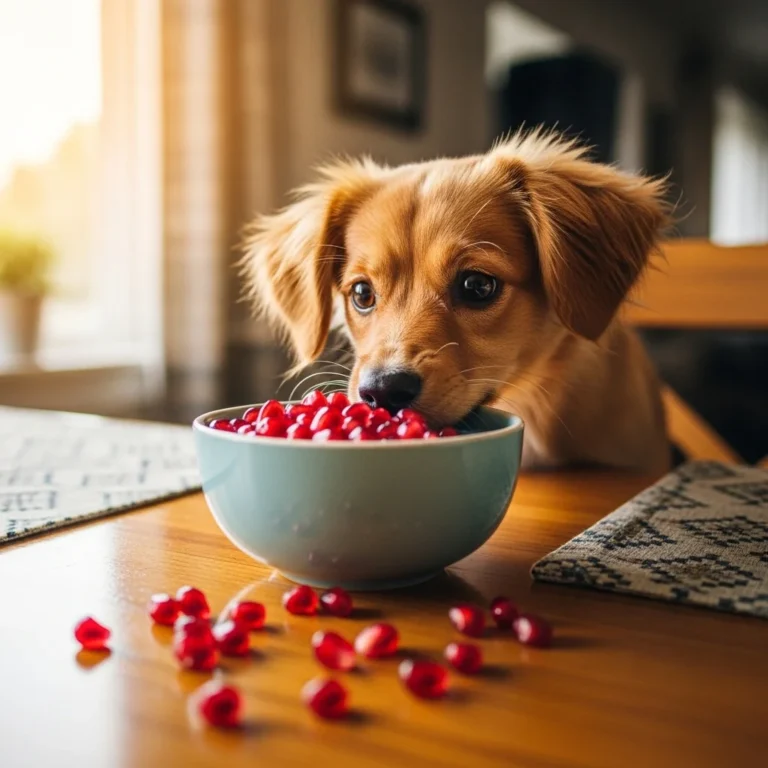
So, you’re snacking on a pomegranate, those little red jewels popping with flavor, and suddenly your dog gives you that look — you know, the “hey, are you gonna share that?” face. And you’re left wondering: can dogs eat pomegranates?
Good question! Pomegranates are basically a health nut’s dream fruit — full of antioxidants, vitamins, and all that good stuff. But when it comes to dogs, things get a little trickier. Some foods that make us feel great can make our pups, well… not so great.
Let’s break it down together — what’s safe, what’s risky, and what to do if your pooch gets into your pomegranate stash. We’ll also cover what the experts say (yep, actual vets like Dr. Jerry Klein from the American Kennel Club), plus some practical tips so you can make smart choices for your furry friend.
Safety & Basic Compatibility
Can dogs safely eat pomegranate at all?
Okay, here’s the deal. According to Dr. Jerry Klein from the American Kennel Club, pomegranate isn’t toxic to dogs. So, if your pup sneaks a few bites, it’s probably not the end of the world.
But that doesn’t mean it’s a great snack idea either. PetMD says it straight — it’s not poison, but it’s risky enough that it shouldn’t be on your dog’s regular treat list (source). Basically: yes, dogs can eat a little, but that doesn’t mean they should.
Is pomegranate toxic to dogs or just risky?
Think of it like spicy food for humans — not deadly, but not always worth the stomach ache. Pomegranate isn’t toxic, but it’s definitely in the “handle with care” category. Dr. Klein puts it best: “Just because you can, doesn’t mean you should.” (source)
Too much can upset your dog’s stomach, especially the rind or seeds. It’s kind of like giving a toddler an espresso shot — possible, but not advisable.
What parts of the pomegranate are safe (or unsafe) for dogs to eat?
Let’s get specific:
- Rind and peel: Big no. Tough to digest, and in large amounts, even mildly toxic (source).
- can dogs eat pomegranate seeds: Seeds/arils (the juicy red bits): These are the best part for humans, but for dogs? Not so much. A couple probably won’t hurt, but too many can cause tummy trouble.
- Juice/extract: If it’s 100% pure and unsweetened, a few drops might be okay. But stay far away from anything with sugar or xylitol — that stuff’s extremely toxic for dogs.
Pro tip: if you really want to share, skip the fresh fruit and look for dog treats that use pomegranate extract — they’re made with pups in mind (source).
Are there breeds, sizes, or life-stages of dogs for which pomegranate is more risky?
Definitely. Smaller dogs and puppies have tinier stomachs, so even a small amount can mess them up. Older dogs or ones with sensitive stomachs should also skip it. When in doubt, call your vet before offering anything new.
Risks, Potential Harms & What Could Go Wrong
What are the health risks if a dog eats pomegranate—what symptoms should I watch for?
If your pup eats too much, watch for vomiting, diarrhea, or just that “ugh, I regret everything” look dogs give when their belly hurts. According to FetchPet (source) and DailyPaws (source), it’s not uncommon for dogs to throw up after eating too much.
If you see ongoing vomiting, diarrhea, or your dog just seems off — it’s vet time.
Can pomegranate cause choking, intestinal blockage, or digestive upset in dogs?
Oh, for sure. Those rind pieces and seeds are a choking hazard, especially for smaller dogs. Even if swallowed, they can cause blockages — which is serious and sometimes needs surgery. PetMD calls that out clearly (source).
Does the rind, peel, or plant parts (leaves/stems) pose additional hazards beyond the edible seeds/arils?
Yep, the peel, rind, and even the plant leaves aren’t just indigestible — they can cause irritation or mild toxicity in dogs. If your dog’s chewing on your pomegranate tree (why do dogs do this?), stop them fast (source).
How much pomegranate is too much for a dog (i.e., how many seeds or how large an amount might trigger issues)?
There’s no magic number, but a couple of seeds is plenty for most dogs. Eating a handful or, worse, a whole fruit? Expect tummy troubles. Petful suggests that even a few bites can cause digestive upset if your dog’s not used to it (source).
Are there hidden dangers like added sugars, sweeteners (e.g., xylitol), or juice/processed forms that are more problematic for dogs?
Oh boy, yes. Many pomegranate juices or snacks have sugar, artificial sweeteners, or — the big one — xylitol, which is super dangerous for dogs. Even tiny amounts can be deadly. Dr. Klein specifically warns against that (source).
So basically, no juice boxes, no fruity yogurt, no chocolate-covered seeds (those are double trouble).
Benefits & When It Might Be Okay
Does pomegranate offer any nutritional benefits for dogs (antioxidants, vitamins, etc.)?
Totally! Pomegranates are loaded with antioxidants, vitamin C, and fiber — all good things. For humans, at least. Dogs might get a small benefit too, but it’s not life-changing. Noble Vet Clinic says there’s some evidence pomegranate can reduce inflammation or support gut health (source).
But here’s the thing — dogs already make their own vitamin C. And if your pup’s eating balanced dog food, they’re covered. So giving pomegranate is more of a “fun experiment” than a health necessity.
In what form (if any) might pomegranate be safe or beneficial—e.g., in extracts, dog-formulated treats, commercial dog food that lists pomegranate?
This is where things get safer (and easier):
- Go for dog-formulated treats or foods that already include pomegranate extract. They’re made to be dog-safe.
- Some pure, unsweetened pomegranate juice in tiny amounts might be fine, but only after checking with your vet (source).
- Skip the DIY fruit bowl — the seeds and rind just aren’t worth the risk.
If I’m going to give pomegranate, how should I safely do it (preparation, portion size, monitoring)?
Here’s your quick “how-to” guide if you really want to share:
- Ditch the rind and seeds.
- Stick to a tiny amount — like one or two juicy bits max.
- Watch for tummy issues for at least 24 hours.
- No sugar, no juice blends, and absolutely no xylitol.
- Keep in mind: treats should only make up 10% of your dog’s diet anyway (source).
Practical What-To-Do & If Something Happens
What should I do if my dog accidentally eats pomegranate or parts of the plant/peel?
If your dog just swiped a few seeds — don’t freak out. Most likely, they’ll be fine. But if they ate the rind, peel, or half the fruit, call your vet right away. PetMD says a couple of seeds aren’t a big deal, but anything more could lead to an upset stomach (source).
JustAnswer vets agree — it’s not toxic, but it can definitely cause diarrhea or vomiting (source).
How long (and what signs) should I monitor after ingestion? When should I call the vet?
Keep an eye on your pup for at least a day. Look for vomiting, diarrhea, or any signs of pain or bloating. If your dog seems off or hasn’t pooped in a while, call your vet immediately. Blockages can become serious fast.
Are there safer alternative fruits or treats I should consider instead of pomegranate?
Absolutely! If your dog’s a fruit fan, try:
- Blueberries — antioxidant kings, and totally dog-safe (source)
- Apples (no seeds), bananas, or melon — all good occasional treats (source)
Basically, there are plenty of fruity options that won’t give your dog’s stomach a meltdown.
Final Thoughts
So, can dog eat pomegranate? Technically, yes. But practically? It’s usually not worth the risk.
A few seeds here and there might not hurt, but that tough rind and those fibrous bits can spell trouble — especially for small dogs. If you love the idea of giving your dog something with pomegranate, grab treats that include it safely instead of sharing straight fruit.
At the end of the day, the goal’s simple: happy dog, healthy belly, no emergency vet visits. So maybe keep the pomegranate for yourself — and toss your pup a blueberry instead. 🐾
please leave comment
you may like it






